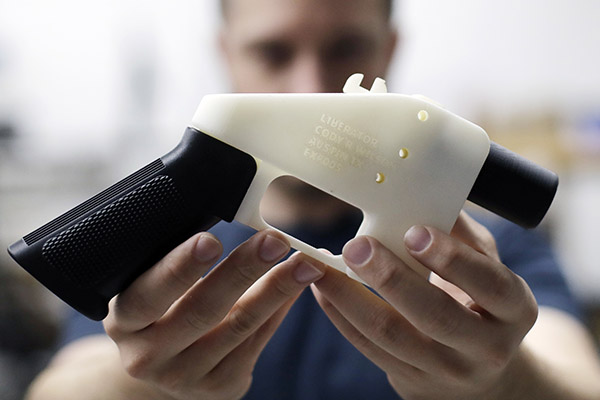We can print plastic guns. But should we?

A debate is raging in the United States about plastic guns. Should the government prevent people from using 3-D printing technology to build plastic guns? Should the citizens who have blueprints for making plastic guns be allowed to upload them for public use? These are questions for the courts to decide, and they’re doing just that on Friday in Seattle.
But there are larger questions underpinning the debate. Is it ethically acceptable to create nearly undetectable guns at home? Is it ethical to release to the public the blueprints for how to make them? In other words, just because we can does it mean we should?
“There are really three different scenarios to consider here from an ethics standpoint,” said John Basl, an assistant professor of philosophy at Northeastern.
Is it appropriate for the government to restrict and regulate what people 3-D print? What is appropriate for an individual to print, regardless of government regulation? And should the companies that manufacture 3-D printing technology restrict their capabilities?
Before considering each of those questions, it’s important to understand what 3-D printing is. Otherwise known as additive manufacturing, 3-D printing is the process of making a physical object by stacking layer upon thin layer of plastic. A 3-D printer operates from a digital schematic of the final product, building an object from the ground up.
“In normal manufacturing, you have a block of material and remove waste until you have the object you want to keep,” explained Mark Sivak, the managing director of Northeastern’s 3-D Printing Studio. Think about an artist chipping away at a block of marble, or an automotive gear that’s cut out of a sheet of metal.
“Additive printing is the opposite of that—you start with nothing and slowly add material until you have the object you want to keep,” Sivak said.
The technology has been around since the 1980s, but has become more popular recently as advances have made it cheaper and easier to use—though it’s still pretty complicated.
“There’s a misconception that 3-D printing works like a toaster, where you give it a design and the thing you want pops out,” Sivak said. “It’s a lot more complicated than that.”
There’s a misconception that 3-D printing works like a toaster, where you give it a design and the thing you want pops out. It’s a lot more complicated than that.
Mark Sivak, Managing Director of Northeastern’s 3-D Printing Studio
To make a gun, for example, one would print individual parts and assemble them, often with the addition of purchased, metal pieces. Unlike commercially-manufactured guns, which are assembled with trackable serial numbers imprinted upon them, these plastic guns, often called “ghost guns,” have no serial numbers and can be printed without government registration.
And while homemade firearms aren’t illegal, the federal Undetectable Firearms Act prohibits people from owning guns that can pass through a metal detector unnoticed. Currently, however, there is no law that prevents someone from distributing the schematics for making such a gun.
Which brings us back to Basl’s ethical considerations: Asking whether the government should restrict someone’s First Amendment right to post what they want online is different from asking whether a person should create a plastic gun—but neither has an easy answer.
Northeastern has a policy that requires students to use the 3-D Printing Studio “exclusively for lawful, non-commercial purposes and in compliance with all university policies,” Sivak said.
So, individual institutions can establish their own restrictions. What about the general public?
“It’s fairly easy to look at the two ends of the spectrum,” Basl said. For example, say someone is a responsible gun owner who keeps their guns locked away, who has passed the necessary testing and permitting processes, and who wants to print a copy of a rare gun to add to their collection.
“It seems pretty likely that we’d say ‘Yes, that’s OK,’ in that scenario,” Basl said.
On the other end of the spectrum is a person who has been prohibited from owning a gun for any reason, and wants to print one instead.
“That’s a pretty likely ‘no’,” Basl said. “It’s everything in between that’s more difficult to decide.”
In the history of human discovery, innovators and inventors generally try things out before considering whether we should. An example of this is genetic testing and modification, where society is still undecided on the morality of re-engineering the genetic code of a live being.
Historically, Basl said, we’ve done things first without thinking about whether we should—genetic testing and modification is a source of such debate.
“But because of the nature of these technological advances, they’re just out of reach for most people, so it’s not a widespread consideration,” he said. “With 3-D printers, there’s much more access. I don’t know if the disposition just to do whatever we can without thinking about whether we ought to is growing or not.”





